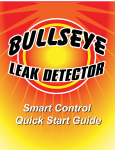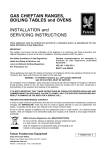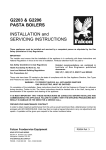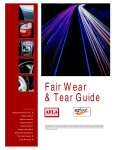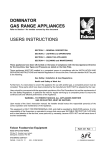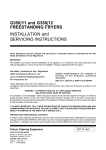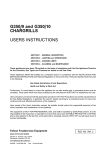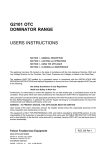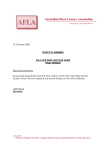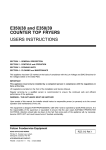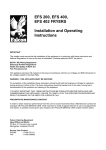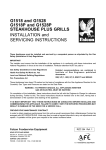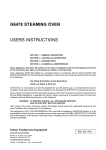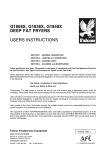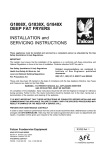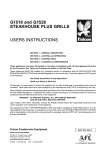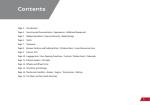Download User Manual - AS Catering Supplies
Transcript
GAS CHIEFTAIN HEAVY DUTY APPLIANCES USERS INSTRUCTIONS SECTION 1 - GENERAL DESCRIPTION SECTION 2 - LIGHTING and OPERATIONS SECTION 3 - COOKING HINTS SECTION 4 - CLEANING and MAINTENANCE These Appliances have been CE-marked on the basis of compliance with the Gas Appliance Directive for the Countries, Gas Types and Pressures as stated on the Data Plate. These Appliances MUST BE installed by a competent person in compliance with the INSTALLATION AND SERVICING INSTRUCTIONS and National Regulations in force at the time. Particular attention MUST be paid to the following: Gas Safety (Installation & Use) Regulations Health and Safety at Work Act Furthermore, if a need arises to convert the Appliance for use with another gas, a competent person must be consulted. Those parts which have been protected by the manufacturer MUST NOT be adjusted by the User. Users should be conversant with the appropriate provisions of the Fire Precautions Act and the requirements of the Gas Safety Regulations. in particular the need for regular servicing by a competent person to ensure the continued safe and efficient performance of the Appliance. WARNING - TO PREVENT SHOCKS, ALL APPLIANCES WHETHER GAS OR ELECTRIC, MUST BE EARTHED Upon receipt of the User's Instruction manual, the installer should instruct the responsible person(s) of the correct operation and maintenance of the Appliance. This equipment is ONLY FOR PROFESSIONAL USE, and shall be operated by QUALIFIED persons. It is the responsibility of the Supervisor or equivalent to ensure that users wear SUITABLE PROTECTIVE CLOTHING and to draw attention to the fact that, some parts will, by necessity, become VERY HOT and will cause burns if touched accidentally. Falcon Foodservice Equipment HEAD OFFICE AND WORKS PO Box 37, Foundry Loan, Larbert. Stirlingshire. Scotland. FK5 4PL AFE SERVICE CONTACT PHONE - 01438 363 000 FAX - 01438 369 900 RZZ 293 Ref. 1 SECTION 1 - GENERAL DESCRIPTION 1.1 Control Knob Details G1006X Open Top Range Piezo Unit (Inside) Open Top Taps Oven Flame Failure Gas Control Oven Flame Failure Gas Control Piezo Unit (Inside) Oven Thermostat Oven Thermostat Bottom Front Panel G1006X Solid Top Range Piezo Unit (Inside) G1016 Single Tier Oven Bottom Front Panel G1016/2 Double Tier Oven Solid Top Tap Oven Flame Failure Gas Control Oven Flame Failure Gas Control Oven Thermostat Bottom Front Panel Piezo Unit (Inside) Oven Thermostat G1006X Twin Bullseye Range Piezo Unit (Inside) Solid Top Taps Oven Flame Failure Gas Control Bottom Front Panel G1029X Two Burner Spreader Oven Thermostat Open Top Taps Bottom Front Panel G1066X Open Top Range Piezo Unit (Inside) Open Top Taps Oven Flame Failure Gas Control Oven Thermostat Bottom Front Panel G1026X Open Top Boiling Table Open Top Taps G1026X Solid Top Boiling Table SECTION 2 LIGHTING AND OPERATIONS LIGHTING THE BURNER 2.1 Open Top Burners All taps incorporate a flame failure facility. The burners are of equal power and the tap which controls a specific burner is identified by the icon adjacent to the tap. See Figures 1 and 2. Rear Left Open Top Taps Front Right Rear Right Figure 1 - G1006X Open Top Solid Top Flame Failure Gas Tap G1060 Open Top Boiling Table Front Left Rear Left Front Left Rear Centre Front Centre Front Right Figure 2 - G1066X Open Top To Light A Burner Rear Right Turn the control knob to the full flame position. Push knob in fully and apply a lit taper to the burner. Continue to hold the knob in for 20 seconds before release. Observe that the burner remains alight. If the burner fails to light, wait 3 minutes and repeat. To Extinguish The Burner Turn the tap fully clockwise to the OFF position. LH Knob Figure 3 2.2 SOLID HOTPLATE RH Knob The single solid hotplate is composed of two filling plates, one rings and one centre bullseye. A radial burner is located centrally below the hotplate. This is operated by the related control knob. See Figure 3 to identify tap markings. The two hotplate version has four filling plates, two rings and two centre bullseyes. A radial burner is located centrally below each hotplate and is operated by the related control knob. See Figure 3 to identify tap markings. Warning If the burner is extinguished intentionally or otherwise, NO attempt to re-light the gas should be made until at least 3 minutes have elapsed. The procedure for lighting a burner, is as follows (Refer to Figure 3) 1. Remove the centre bullseye using the special tool provided. 2. Have a lit taper or match ready in one hand. 3. With the other hand, push the control knob in and turn it anti-clockwise until the knob mark is aligned with the ignition symbol. 4. Apply the taper or match to the pilot, keep the knob pushed in. 5. Release the knob after approximately 20 seconds. The pilot should remain alight. If not, push in the control knob and turn it clockwise to the off position. Wait 3 minutes, then repeat form Step 2. 6. Having established the pilot flame, replace the centre bullseye. 7. Turn knob anti-clockwise to the full flame symbol. 8. If desired, the burner can be turned down to the low or simmer setting by turning the knob fully anti-clockwise to the low flame symbol. To Turn the Burner OFF 9. To turn a burner down but leaving it lit, turn the knob to the ignition symbol. 10. To extinguish a burner, push the knob in and turn to the off position. Note Most turning movements of the knob have to be preceded by pushing it in. Using the Solid Hotplate Getting the best out of this type of heat source is largely a matter of experience coupled with the requirements of the task in hand. For certain applications such as heating a pot quickly, it is expedient to remove the centre ring and place the pot directly over the burner. If it is necessary to heat the entire surface, the ring must be in position. In the interests of economy, it is recommended that the unit should not be left unattended on full setting. If it is necessary to keep the hob area hot for any length of time, the control should be set to low. Never leave the gas on without a pot when the centre ring has been removed as such practice wastes energy. The hottest area of the plate is the centre of the bullseye and toward the rear. The front and sides are cooler. 2.4 SOLID HOTPLATE The single solid hotplate is composed of two filling plates, a ring and a centre bullseyes. The burner is located directly below the centre ring and is operated by the related control knobs. See Figure 4 to identify the tap icons. Warning Figure 4 Should the burner become extinguished intentionally or otherwise, NO attempt to relight it should be made until at least 3 minutes have elapsed. The procedure for lighting a burner, is as follows (Refer to Figure 4) 1. Remove the centre bullseye using the special tool provided. 2. Have a lit taper or match ready in one hand. 3. With the other hand, push in the control knob and turn it anti-clockwise till the knob mark is opposite the ignition symbol. 4. Apply the taper or match to the pilot while keeping the knob pushed in. 5. Release the knob after approximately 20 seconds. The pilot should remain alight. If not, push the knob in and turn it clockwise to the off position. Wait 3 minutes, then repeat form Step 2. 6. Having established the pilot flame, replace the centre bullseye. 7. Turn the knob anti-clockwise to the full flame symbol. 8. If desired, the burner can be turned down to the low or simmer setting by turning the knob fully anti-clockwise to the low flame symbol. To Turn the Burner OFF 9. To turn a burner down whilst leaving it lit, turn the knob to the ignition symbol. 10.To extinguish a burner, push the knob in and turn it to the OFF position. 2.3 OVEN The oven controls are located on the RH side of the unit. These consist of a thermostat and a multi-purpose gas cock/flame supervision control. A piezo igniter is located behind the bottom hinged panel to ignite the pilot burner. See Figure 3 to identify the gas tap icons. Warning If the pilot burner is extinguished either intentionally or otherwise, no attempt to re-light the gas should be made until at least 3 minutes have elapsed. The procedure for lighting the burner is as follows: (Refer to Figure 4) 1. Lower the bottom front panel and turn the thermostat knob to 277oC. 2. Push the tap in and turn it anti-clockwise to the ignition position. 3. Holding the tap fully in, press the igniter button and observe that the pilot lights. If it does not light, repeatedly press the igniter button until it does. 4. When the burner is lit, continue to hold the tap fully in for 20 seconds then release it. If the burner goes out, push in the control knob and turn it clockwise to the off position. Wait for 3 minutes, then repeat from (1). 5. When the burner is established, turn the tap anti-clockwise to the full flame position. (large symbol), thus lighting the burner. 6. Close the bottom front panel and turn the thermostat knob to the setting required. 7. For low flame or simmer position, push in the tap and turn it anti-clockwise to the low flame position (small flame symbol). This setting gives an economy control on the oven burner. To Turn the burner OFF 8. To turn down the oven burner to ignition rate, turn the knob to the ignition symbol position. 9. To turn off the main burner and pilot, push in the knob and turn it to the OFF position. Turn the thermostat knob to the OFF position also. Using the Oven The oven temperature is controlled automatically by a thermostat. Leave the burner tap full on during the period the oven is in use. The following cooking charts give basic temperatures and times required but for best performance the following instructions should be carried out. Shelves 2 shelves are supplied with the unit which can be supported in any of four different positions within the oven. When 2 shelves are used these should be positioned with at least one shelf space left between them (i.e. top and 3rd top or second top and bottom positions). Always push the shelves all the way to the oven rear and ensure they are inserted correctly, i.e. shelf stops at the rear pointing upwards. Tray Size Tray sizes up to a maximum of 650 mm x 530 mm can be used. Smaller trays should be placed centrally on the shelves. The oven accommodates 2/1 gastronorm trays. Pre-heat Time Allow at least 45 minutes to heat the oven up from cold before loading with food. Put the food in quickly to minimise heat loss and close the door firmly after insertion. SECTION 3 - COOKING HINTS 3.1 Small cakes, scones etc, When preparing two trays, the upper tray will be cooked first. It should then be removed from the oven and the lower tray raised to the upper position. 3.2 Yorkshire Puddings etc, in baking tins When cooking on two shelves, the upper and lower tins should be interchanged half-way through the cooking process. 3.3 Fruit cakes in large tins Cooking time will vary considerably according to weight, richness and depth of mixture. When cooking on 2 shelves, tins should be interchanged halfway through the cooking process. Approximate centre oven temperatures are indicated in the following table: oC 125 - 150 175 200 - 225 250 275 Condition Slow Moderate Fairly Hot Hot Very Hot Cooking Charts Temp. Shelf Time Setting Position Fruit Pies 225 3 for 35 to 45 mins Plate Tart 225 single tray, 30 to 40 mins Puff & Rough 2 & 4 15 to 25 mins Puff Tarts 250 for Sausage two Rolls 250 trays. 20 to 25 mins Scones 260 10 to 15 mins PASTRY PUDDINGS Custard Milk Yorkshire Pudding Temp. Shelf Time Setting Position 165 40 to 60 mins 150 45 to 90 mins 240 33 to 40 mins Temp. Shelf CAKES Time Setting Position Slab Cake (Rich) 150 3 hours 3 for 1 single 1 /2" Slab Sponge 200 tray, 25 to 35 mins Queen 2&4 Cakes 200 for 20 to 25 mins two Sponge trays. 20 to 25 mins Sandwich 200 Very Rich Cake(Xmas) 150 3 2 to 21/2 hours Bread as Slab Rolls 250 Cake 15 to 25 mins SECTION 4 - CLEANING AND MAINTENANCE It is advised that the unit be cleaned daily after use. This should be carried out using hot soapy water, ensuring that it be thoroughly rinsed and dried after any such cleaning. Grease should be removed with nylon or scotch cleaning pads. Take care, especially when these are new as they may cause scratching. A smooth-bladed metal scraper is handy to remove deposits of burned-on grease from hob fillings. Before removing any of the parts described below, note how they are arranged and replace in the same position. 4.1 OPEN HOTPLATES Pan supports, burners and spillage trays can be easily removed for cleaning. After washing, dry the burners thoroughly and remove any excess water from inside. The burners are interchangeable. Ensure that burner caps are located correctly. Pan Supports Clean with warm soapy water. Abrasives such as fine steel wool, proprietary cleaning pads and nylon pan scrubbers should only be used in cases of extreme overspill with care. Dry pan supports thoroughly by hand. NEVER LEAVE TO DRY NATURALLY. After drying, apply a light film of vegetable oil to the supports to prevent oxidation. 4.2 SOLID HOTPLATES Plates can be removed for cleaning access. Having gained access, clear accumulated debris which may have gathered in the burner tray, particularly that which has gathered at the hotplate support edges. Warning The castings are very heavy and care should be taken during handling of such components. 4.3 OVEN The oven linings are stainless steel and can be cleaned easily. Wipe down with a soapy cloth while the oven is still warm. Shelf runners can be removed as follows Lift upward and pull the bottom edge toward the oven centre before dropping the runner. To replace a runner, ensure that the long leg is at the top. Replace the shelves correctly. Base linings can be removed by lifting the rear lining slightly and pulling out the base panels. Cleaning Note Important Never clean with a jet of water or steam clean.





